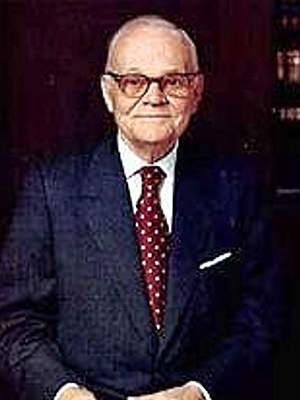Marion G. Romney
Marion George Romney (September 19, 1897–May 20, 1988) was an Apostle and a member of the First Presidency of The Church of Jesus Christ of Latter-day Saints.
Contents
Early life
Romney was born in Colonia Juárez, Chihuahua, Mexico, to parents who had come from the United States. His grandparents on both sides had left the U.S. to avoid prosecution over polygamy laws. Romney was the son of George S. Romney. Brother Romney studied at Juarez Academy until his family left Mexico when he was 15.Romney's family left Mexico in 1912, as violence from the ongoing Mexican Revolution spread to their region. He spent the remainder of his youth in California and Idaho. In 1917 the Romney family moved to Rexburg, Idaho, where George S. Romney took the position of principal of Ricks Academy. Romney completed his high school study at Ricks as valedictorian of his class in 1918.
From 1920 to 1923 Romney was a Missionary in Australia. After his return from his mission, he worked in construction in Salt Lake City for his uncle Gaskel Romney (the father of George W. Romney).
Education and family
Romney studied at Brigham Young University (BYU) for a year. While there he renewed his acquaintance with Ida Jensen, a former teacher at Ricks who was working on a master's degree at BYU.
Marion Romney and Ida Jensen were married on September 12, 1924, in the Salt Lake Temple. The marriage was performed by Joseph Fielding Smith.
After this Romney began studying at the University of Utah. He received a bachelor's degree in political science and history in 1926. Romney then studied law at the University of Utah. He did not complete course work there. However he did pass the bar in 1929.
Romney and his wife Ida had three children, of whom only one, George J. Romney, lived to even be one year old. They also had another child who was stillborn. George J. Romney did live to adulthood, served a mission, and in April 1983 read President Marion G. Romney's general conference talk for him. The Romneys also had an adopted child, Richard Jensen Romney.
Church service and politics
Before his call to be an Assistant to the Quorum of the Twelve Apostles, Elder Romney was an assistant prosecuting attorney in Salt Lake City. He had previously worked for the post office.
He also was elected to the Utah state legislature in 1934. While running for the state legislature, he accepted a call as a bishop from his stake president, Bryant S. Hinckley. Due to his election to the state legislature, his ordination as a bishop was delayed until after the end of the legislature's term, in April 1935. While in the legislature, Romney had been a key figure in writing Utah's Liquor Control Law. After the end of that session of the legislature, Romney resigned from the legislature.
In 1936 Utah Governor Henry H. Blood appointed Romney to fill the vacancy in the legislature he had caused by resigning.
General authority
Romney's 47 years as a general authority of the Church of Jesus Christ began when he became one of five persons called to fill the new position of an Assistant to the Quorum of the Twelve Apostles in 1941 (the position was abolished in 1976). In 1951, he was advanced to the Quorum of the Twelve Apostles. In 1960 Romney was among those who developed the Home Teaching program.
In 1961 Romney was appointed the area supervisor for the Church over Mexico. Although he had lived his first fifteen years in Mexico, it was in the mainly American Mormon Colonies, so he knew very little Spanish. Romney did try to learn more Spanish, an endeavor in which he was assisted by Eduardo Balderas. Romney supervised the Church's growth in Mexico for the next eleven years. He oversaw a plan that allowed for the Church to build many chapels in Mexico, and it was during this time that the first stakes in Mexico made up primariy of Spanish speakers were organized.
Romney became second counselor in the First Presidency when Harold B. Lee, with whom he had worked on the Church Welfare program, became Church president in 1972.
Lee's death the following year brought Spencer W. Kimball to the church presidency; who retained Romney and first counselor Nathan Eldon Tanner in their positions. As Kimball, Tanner, and Romney all became octogenarians and developed health problems, it was decided to add Gordon B. Hinckley as an additional counselor in 1981. Upon Tanner's death in 1982 Romney was named first counselor and Hinckley second counselor, but Romney was fairly inactive in this position. When Kimball died in 1985 press reports indicated Romney had not been seen in public for many months.
Ezra Taft Benson, who had been President of the Quorum of the Twelve Apostles, became the next church President and named Hinckley his first counselor. Romney, as the next longest serving Apostle after Benson, succeeded as of right to the position of President of the Quorum of the Twelve Apostles. However, "because President Romney’s health [kept] him from taking an active part in Church administration," Howard W. Hunter, who ranked next in seniority, was made Acting President of the Quorum of the Twelve (Ensign, Apr. 1986). Romney was never formally set apart to his new position.[citation needed]
President Romney died at his home in Salt Lake City from causes incident to age. He was 90 and had been a Church general authority for 47 years. Funeral services were held on May 23, 1988 at the Salt Lake Tabernacle under the direction of Ezra Taft Benson. Romney was buried at Wasatch Lawn Memorial Park in Holladay, Utah, beside his wife who preceded him in death in 1979.
On Elder Romney's death, the Deseret News Church Almanac remembered him as a "renowned Church Welfare pioneer and Book of Mormon scholar".
See also
Sources
- Howard, F. Burton, Marion G. Romney: His Life and Faith. Salt Lake City: Bookcraft, 1988.
